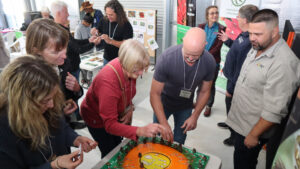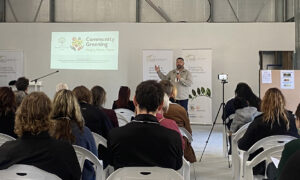The role Australian bushfoods play in our urban environments
By Michael Casey
This year’s Australian Bushfoods Conference, held in the City of Logan, Queensland, showcased the diverse range of professionals working in the Bushfoods sector. Titled ‘Design and Development of Urban Landscapes for Bush Foods’ the conference was a showcase of best practices around Australia in bush food culinary use, cultivation, and production, along with designing of green spaces using bushfoods and native plants.
Held at the Australian Technology and Agricultural College, and presented by the Australian Institute of Horticulture and the Queensland Bushfood Association, the conference was attended by more than 80 attendees and covered topics ranging from bush food production and management, to research around the health benefits of these unique foods, and the design elements we need to consider when using bush foods in our urban landscapes.
The two-day event started with a warm welcome to country and a discussion from the organising committee on the future of Australian bushfoods, and the industry as a whole. The importance of bush foods was highlighted when speakers discussed how this unique sector can now start to look to new areas of the industry (such as design and urban spaces), and where designers and the public’s understanding about bush foods has presented new opportunities for their businesses.
On the first day, speakers presented mainly on plants, and the indigenous and social connections we have with bush foods and plants in general. Brenden Moore, First Nations Community Greening Officer from the Sydney Botanic Gardens, spoke about the connections First Nations people have with plants, and how he and his team are using plants and bush foods to help communities discover this connection. His discussion finished with a workshop where a fantastic hand-painted art piece was finished with hakea and flowering gumnuts attached by all members of the conference. Brenden highlighted the strong significance of our native plants and bush foods. He stated that “First Nations people are custodians, knowledge and skill sharers, bringing us all together to pass onto the next generational custodians.”

Gerry Turpin from James Cook University followed up Brenden’s discussion about the many bush tucker projects he and his team are involved in.
After a beautiful morning tea and lunch, which included many delicacies created from bush food ingredients, we moved into the plant cultivation segment of the agenda with Jade King talking about Finger Limes, Attila Kapitany highlighting the many Australian native succulents that are edible, and Vinesh Prasad highlighting his company’s involvements in Macadamia, Finger lime and Davidson Plum production. Angela Seng-Williams, Head of Engagement and Advocacy at the Queensland Fruit and Vegetable Growers, wrapped up the session highlighting the industry organisations’ involvement.
The sessions in the afternoon included Dick Copeman talking about working alongside First Nations peoples, through to Sophie Ader from the Centre for Nutrition and Food Sciences, where the audience was informed about examples of successful indigenous-led native botanical value chains which are making a huge difference. Dr Ian Cock highlighted his findings on the Kakadu Plum and the anti-inflammatory properties it possesses, and Jude Mayall, the QLD Bushfoods Association President, talked through the many culinary uses of bush foods. To finish off a huge opening day, the delegates listened to Paula Nihot present on local plants as seen and valued through story and language.
A very sincere thank you also needs to go to co conference organiser Nerandra Nand and his family for the catering and the hospitality for the evening dinner, along with First Nations delegates Brenden Moore and Clarence Slockee who entertained the dinner guests with an insightful look into First Nations welcoming culture through song and dance.
Day two started with more discussions on the many available plant species on the commercial market with Mark Tucek from Tucker Bush, through to a presentation on the nutritious side of indigenous plants from Dr Andrew Pengally, and Madhukar Padma Kalvva highlighted the many First Nations activities, and growing of native foods, on his Galeru Bushfoods Property.
Clarence Slockee from Jiwah and myself, Michael Casey from Evergreen Infrastructure, addressed the delegates on urban greening and green infrastructure, and the roles of bush foods and indigenous plants as important plant solutions for creating and improving biodiversity in our built environment. The afternoon concluded with a presentation from Russell Stamford about his work on grafting Kakadu Plum onto a Sea Almond rootstock, before the delegates found themselves back in class mode as plant ID became a topic with Alan Knight.
Congratulations to the conference organisers for the work carried out on organising and running this two day bush foods discussion and information session. Neranda Nand and Professor Rod Drew worked tirelessly to deliver this event, and with the assistance of Irena Babylon and Sheryl Backhouse, and AIH National President Alan Burnell and myself, I feel the 2023 Bushfoods Conference was a success, opening the eyes of our horticultural industry to the world of native bush foods. I, and others, are now looking forward to next year and the opportunities that await.
Michael Casey, Director of Evergreen Infrastructure
and MJC Horticulture
Advisor to the green infrastructure industry.
E: michael@evergreeninfrastructure.com.au
Main photo: Brenden Moore addressing the Bush Foods Conference (Image: Michael Casey)

